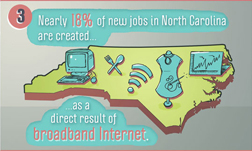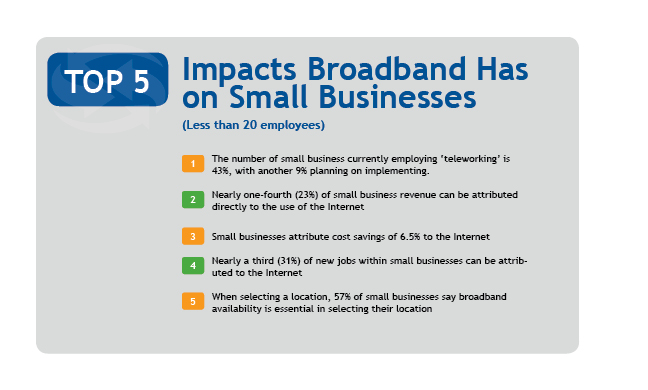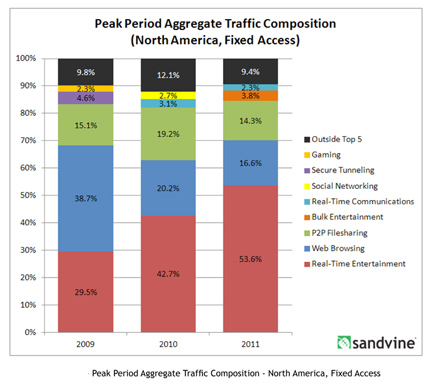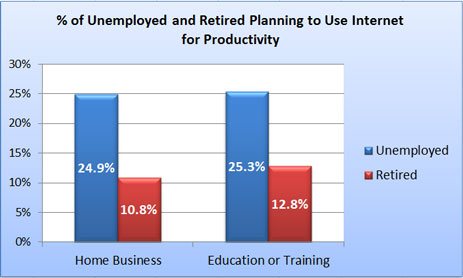
Its the end of the year – and that means “Best Of” list. We’ve had some great research findings and article submissions this past year – in this year-end edition of Bandwidth, we’re sharing our favorites…
Broadband and Revenue Growth Increasing Internet utilization dramatically increases corporate revenues and job creation
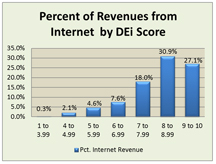 An SNG study of nearly 600 businesses revealed a direct correlation between revenue growth and the adoption and use of e-solutions. Higher levels of utilization generate higher revenues and greater benefits for businesses. The most significant impacts on a firm’s bottom line are more sophisticated e-solutions such as teleworking, selling goods or services online, etc. – which means that firms that are not ‘fully online’ are missing out on significant potential revenue. In some cases they could grow by up to 30%.
An SNG study of nearly 600 businesses revealed a direct correlation between revenue growth and the adoption and use of e-solutions. Higher levels of utilization generate higher revenues and greater benefits for businesses. The most significant impacts on a firm’s bottom line are more sophisticated e-solutions such as teleworking, selling goods or services online, etc. – which means that firms that are not ‘fully online’ are missing out on significant potential revenue. In some cases they could grow by up to 30%.
By measuring over 17 activities classified as “e-solutions,” or Internet enabled applications, SNG has developed a Digital Economy index (DEi) which measures the utilization of broadband as a platform for innovation. DEi scores range from 1 to 10 (10 being highest), with higher scores reflecting the greater the number, scope and sophistication of the Internet activities deployed in an organization.
Businesses with a high DEi, meaning higher levels of adopting and using e-solutions, experience larger percentage increases of revenues (between 27 and 31%).
Read More on the SNG Blog>>
New Dimensions in the Digital Divide
The digital divide has long been commonly understood to mean unequal access to the Internet and its accompanying resources and services. Earlier this year, we showed how when connectivity expands to more households, as we look at how people use and benefit from the Internet, another dimension to the digital divide emerges. SNG’s research (below) shows:
- Computer and Internet skill levels affect broadband utilization, but more interestingly:
- The lower your income, the lower your utilization.
- The older you are, the lower your utilzation.
 Click on chart for a larger version.
Click on chart for a larger version.
SNG’s proprietary Digital Economy index (DEi) was used to develop this chart. Measuring how households use thirty distinct Internet activities yields a DEi score. The higher the DEi, the more Internet activities a household engages – 10 being a household at 100% utlization. As utilization is impacted by income and age – the lower a household income or the older the household, the lower its Internet utilization. The differences (or divide) is most pronounced for those over 55 and those making less than $30,000. So the digital divide is actually expanding as younger, higher income households best leverage e-solutions. Read the full article >>
Broadband and Job Creation
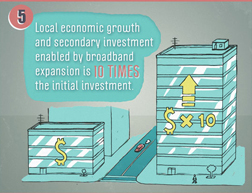 The Internet Innovation Alliance (IIA) released its 10 ways broadband contributes to job creation and serves as a connector of job seekers, employers and employees. Sources for the research include the American Library Association, the Federal Communications Commission, and SNG. Click here for the top 10 list.
The Internet Innovation Alliance (IIA) released its 10 ways broadband contributes to job creation and serves as a connector of job seekers, employers and employees. Sources for the research include the American Library Association, the Federal Communications Commission, and SNG. Click here for the top 10 list.
Our two contributions show the multiplier effect broadband investment has, as well as how many NEW jobs in North Carolina were created as a direct a result of broadband.
Broadband and Small Business
Using SNG’s Digital Economy Analytics Platform (DEAP), containing data from regions across the U.S. and the globe, SNG revealed the top 5 impacts broadband has on small business:
Broadband and the Unemployed
One out of four unemployed individuals are using the Internet to start a home business. While another 25% are relying on the Internet for education and training to help them get their next job. Even the retired are using the Internet for both of these purposes.
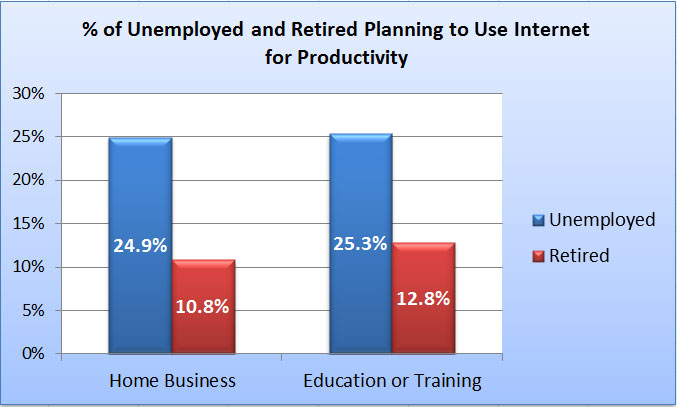 n= 229 unemployed, 868 retired
n= 229 unemployed, 868 retired
Visit SNG’s research library for more findings >>
Our Favorite Bandwidth Articles of 2011
In case you mised it, each month SNG provides insights and research into the world of broadband. In case you missed them, here are a few articles we thing you should take a minute to review…
Change is Hard… and So is Utilization
Are you focusing on simply providing broadband and waiting for people to adopt… and ultimately utilize e-solutions (the tried and failed build it and they will come mentality) or are you driving utilization? Focus on driving sophisticated use of broadband and you’ll see your region’s economy reap the benefits. Read Article>>
Making the Most of Your Broadband Investment
Broadband is critical infrastructure, a means to an end – not the finish line. Neither broadband coverage alone nor adoption is sufficient to achieve your goals and outcomes. Only broadband utilization leads to desired economic and social benefits. Read Article>>

What Steve Jobs Taught Us About Driving Broadband Utilization
Broadband has the ability to radically change our entire world in orders of magnitude more than it already has. But we need to get past the utilitarian view of broadband – looking at what it enables and instead what it empowers. At the advent of broadband, Apple’s campaign challenged us to push the world forward. Is what we’re doing enough to drive the complete transformative power of broadband… or do we need to Think Different? Read More>>
Creating an Action Plan for Broadband Utilization
Broadband availability alone is not enough to realize its social and economic benefits. An understanding of how to effectively use of broadband for commerce, citizen services and the positioning of rural counties as attractive areas for 21st century business and living will play a critical factor in their long-term success of your broadband investment and your ability to impact the lives of the citizens and businesses already located in the regions. Read More>>
The State of the Divide in 2011
More than a decade into our broadband revolution, the knowledge economy, and e-everything, it’s a bit discouraging to find that, even today, geography can still dictate individual or organizational potential for success. Read More>>
Uncovering the Value of Rural Broadband
SNG’s research shows that broadband strongly influences locational decisions by both businesses and households about whether to stay or where to move. Our research also shows that consumers consider the speed and reliability of their broadband in making these decisions. Read More>>

Don’t Let Your Region be a “No Place”
Without compelling reasons, applications, and e-solutions for your constituents to utilize your broadband network – the hopes you have for its transformational power are sure to come up short. Read More>>
SNG Announces Industry’s First and Only Hands-On, Comparative Database
Digital Economy Analytics Platform from SNG enables SNG clients to compare regions and industries to uncover actionable information and insights. With this new solution from SNG, regional leaders can leverage the best practices from each region and industry across their territory. Read More>>

By John de Ridder
The popularity of Netflix illustrates how market and technology shifts are posing headaches for carriers. Canada has recently tried to address bandwidth pricing but expect more developments.
In 2007, Netflix started streaming its movie and television catalogue to subscribers in the USA and now has over 23 million customers in place. The same unlimited movie download offering was expanded to Canada in 2010 at a cost of $7.99 a month. By August 2011, the service had signed up 10% of Canada’s broadband households; where signing up the same percentage (albeit more homes) took six years in the United States.
The success of the Netflix offerings is starting to create headaches for carriers and ISPs as they do not get revenue contribution from over-the-top applications like Netflix and yet have to invest to carry the extra traffic. The headaches remain after the Canadian Radio-television and Telecommunications Commission’s (CRTC’s) recent decisions.
Bandwidth Headaches
Digitization of broadband networks (both fixed and mobile) is causing tectonic shifts in business models. Traditionally, carriage and content went together: not any more. Entertainment was the ‘killer app’ that spurred the building of cable networks. The builders assumed they would be the providers of the content. But the impetus for delivering content over broadband is now coming from non-traditional sources that do not build the networks they rely on.
Not only have the builders of networks been deprived of the revenues that they expected out of video, but also have to augment their networks to keep-up with the growth in video traffic; for which they earn very little. Over half the current downstream traffic on fixed networks in North America is accounted for by real time entertainment.
“Intelligent broadband network solutions” provider Sandvine reports that Netflix accounted for 32.7 percent of all North American peak fixed access downstream content in the Fall of 2011. That puts Netflix way beyond the other three top Internet protocols or services by daily volume—approaching double HTTP (17.48 percent), almost three times YouTube (11.32), and nearly four times BitTorrent.
Some carriers’ knee-jerk reaction to the first manifestation of this kind of traffic was to block file-sharing networks like BitTorrent. This was discriminatory and not compatible with net neutrality.
The obvious neutral solution is to charge per GB irrespective of the content or its source. Volume based charging goes against the grain for those accustomed to unlimited downloads on broadband. And it is bad news for Netflix at about 2GB per hour (double with high definition) and average usage around 40GB per month. Twenty Organization for Economic Cooperation and Development (OECD) countries have no data caps at all among their broadband offers. But things are changing. Most Netflix customers are in the USA and in May 2011, AT&T slapped 150Gb and 250GB data caps on its DSL and U-Verse customers. This remedy has been over-turned in Canada.
Canada
In 2000 the CRTC permitted cable carriers to introduce usage caps and/or usage-based billing (UBB) charges for their wholesale services if UBB was also applied for their retail customers. Later, this option was extended to telephone companies offering broadband access.
On 25 January 2011 (Decision 2011-44), the Commission set the UBB rates at retail minus 15 percent. But the concession was not enough for many independent ISPs which together account for just 6 percent of the residential retail market. They hoped the CRTC would set a 50% discount. The January decision ignited consumer backlash and created a wave of public scorn that hit Ottawa ahead of the May federal election, quickly turning into a hot-button issue for a minority Conservative government and opposition parties alike. Also Netflix Inc. expressed serious concerns about its future in Canada – “[usage-based billing] is something we’re definitely worried about,” (Reed Hastings, chief executive of Netflix). On February 3, 2011, the federal Cabinet advised the CRTC that if it did not review the decision and come back with a new one, it would be reversed.
What does this mean going forward for bandwidth pricing?
The revised model that the CRTC finally produced on November 15, 2011 offers two options. First, for companies that proposed a usage-based model, their tariffs have to be based on the approved capacity model, effective February 1, 2012. For companies that proposed a flat rate model, their tariffs were approved effective immediately.
The capacity model requires ISPs to choose what bandwidth of pipe it wants in order to carry traffic between aggregation points (e.g. street cabinets) and the handover point. This is similar to the wholesale model proposed for the new broadband network in Australia. If ISPs do not order enough capacity, their traffic will become congested without affecting other ISPs.
This should appease Netflix and others but where is the incentive for ISPs to buy bigger pipes to accommodate traffic for which they get little or nothing? The bandwidth headache will remain until get to linear pricing on volumes. Data caps are just the first step towards that.
Sources:
CRTC Telecom Regulatory Policy CRTC 2011-703 [15 Nov 2011] http://www.crtc.gc.ca/eng/com100/2011/r111115.htm
Financial Post , 1 October 2011 http://www.nationalpost.com/news/Netflix+face+Canadian+regulations/5487301/story.html
Financial Post, 16 November 2011 http://www.financialpost.com/news/CRTC+ruling+hits+smaller+ISPs/5716827/story.html
OECD Communications Outlook, 2011
Sandvine, Global Internet Phenomena Report, Fall 2011 http://www.sandvine.com/news/global_broadband_trends.asp
Competition and Broadband in the EU
by Joanna Taylor
In Europe there is a healthy competitive market for the telecommunication services, including broadband services, to end users. What is the basis for this competition? The fundamental attributes are explored briefly below. Could they be transferred to the western side of the Atlantic? There seems to be no reason why not!
 Economists and lawyers generally agree, to the extent that they agree upon anything, that healthy competition is a “good thing.” Competition drives down prices and encourages innovation while its opposite state, a monopoly creates an environment where innovation is limited and there is no market pressure driving down prices. In essence, an open, competitive market provides a higher degree of public good than a monopolistic, closed market focused on exploiting its market dominance to maintain high prices or restrict investment.
Economists and lawyers generally agree, to the extent that they agree upon anything, that healthy competition is a “good thing.” Competition drives down prices and encourages innovation while its opposite state, a monopoly creates an environment where innovation is limited and there is no market pressure driving down prices. In essence, an open, competitive market provides a higher degree of public good than a monopolistic, closed market focused on exploiting its market dominance to maintain high prices or restrict investment.
Economists and lawyers often refer to “natural monopolies,” as those that result from a set of circumstances where only one supplier is likely to enter the marketplace. It is argued that these conditions are present in the telecommunications access market. For example, when the final section of a wired (fixed line or last mile) service closest to a house or business premises is dedicated to the individual customer, and most customers only have the opportunity to purchase service from a select provider, there is very limited opportunity for a second provider to invest profitably in a duplicate access network. This is equally true in the broadband and mobile/wireless contexts and on both side of the Atlantic ocean.
Typically the incumbent, or first operator, will have created a largely universal copper network, and indeed has sometimes had an obligation to do so. In comparison, a new market entrant in its start-up phase would typically not be able to afford to re-create such a network in its entirety and will need the capability to link to the other network to provide the services they are marketing to potential customers. Typically, the service package includes the customer’s ability for their customer’s calls to connect with their competitor’s customers. However, if a new entrant’s network is unable to deliver calls made by its customers to people or organizations that procure services from another provider the new entrant will fail. In contrast, the profit maximising position for a monopoly network operator would be to refuse to deliver calls that originate from another network, or charge extortionate amounts to do so.
If market entry is to be encouraged, some form of regulation is required to force provider interconnection and control its prices.
In Europe, these twin concepts of the benefits of competition and the natural monopoly of the access market have long been recognized as appropriate solutions to sustainable competition and new market entry. Two recent public consultations on the regulatory regime have focussed on how to increase effective operation without any perceived need to discuss if the fundamentals require changing.
The European regulation that supports this service level competition is based on European competition law. The key difference is, however, that the regulation restricts behaviours in advance, ex-ante rather than ex-post, to prevent potential exploitation by operators of monopoly or quasi monopoly positions. As noted above, exploitative monopolistic behaviours may take the form of excessive pricing or market foreclosure, and the rules operate to counter both.
In brief, the system is as follows:
- The regulator has an obligation to review the telecommunication markets every few years and assess if any operator has significant market power (SMP), broadly equivalent to 40% market share, that would enable it to act anti-competitively,
- If an operator is found to have SMP, it can be required to offer wholesale services to other operators that enable them to compete on the retail market,
- These wholesale services should typically be offered on a non discriminatory basis to all other operators, and the retail arm of the operator with SMP should consume those same services when delivering services to its end customers, and
- The prices for the wholesale services should be cost orientated, and there should be sufficient margin between the wholesale and retail prices to cover the costs of retailing.
Over time the number of SMP markets has tended to fall, as competition has developed and entrants have built their own networks. A market entrant will initially invest in a core network, and as its customer base grows, it builds its network out towards the edge of the network, concentrating on the areas of highest customer density and value as this is where the opportunities are greatest . Former TV Cable operators may compete with the ex-incumbent in urban areas but SMP may remain with one, or both operators. The degree of competition in the access network remains limited outside city centres.
This European regulatory standards body is not without its critics, and its implementation, which varies somewhat country by country, could be improved but there is no doubt that the new regulatory standards have created an explosion of service level competition. Not only have consumers and businesses seen significant benefit, but also significant price reductions have been seen in the retail fixed and mobile markets.. Broadband services have got faster without price increases. In the European Union there are over 250 million internet users, with 95% of the population having fixed broadband access available to them, and virtually every European owns a mobile phone .
The regime has not restricted investment in infrastructure, as the roll out of fibre networks into high-density areas demonstrates. A proposal from Germany to exclude fibre networks from the rules was firmly rejected by the European Court of Justice in 2009.
The target for basic broadband for the 100% of the European Community by 2013 and 30mbits by 2020 is being made within this framework, and any development that uses pubic funds for network development is captured.
What would North America look like if this model were adopted? There is interconnection and the FCC requires some services to be offered on a wholesale level, but the whole process is shrouded in complexity. A general obligation for local access providers to provide wholesale services and to consume them themselves in a transparent and non-discriminatory manner might be just the catalyst the market needs!
How easy would a move to this model be? Well, that depends on the hearts and minds of those involved. The European model does not prevent operators being successful or prevent those who are inefficient from failing. The most successful are those that understand the logic of the competitive model and embrace it, whether as incumbent or entrant. Perhaps now is the time that this approach should be considered?
Quick Bytes
The U.S. Department of Commerce recently released a report entitled “Exploring the Digital Nation – Computer and Internet Use at Home – a long report with several important findings. But our favorite happens to be results showing why the 32% of American homes without home Internet access don’t subscribe to a service.
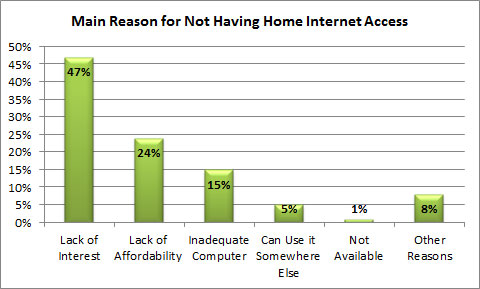 So there are more than 34 million households in the U.S. without Internet access… and while we’ve been quick to blame the digital divide, the price, that does not seem to be the main challenge. Even if we combine the numbers for Affordability (24%) and Inadequate Computer (15%), it still comes in below the number one reason: Lack of Interest. So while affordable, pervasive availability is critical – it is just as important (if not moreso as the study suggests) to show the “So What” of broadband… WHY should people adopt and then utilize broadband and its e-solutions?So while the digital divide is real and significant – perhaps as broadband evangelists, we should focus just as much effort on the the “understanding” divide.
So there are more than 34 million households in the U.S. without Internet access… and while we’ve been quick to blame the digital divide, the price, that does not seem to be the main challenge. Even if we combine the numbers for Affordability (24%) and Inadequate Computer (15%), it still comes in below the number one reason: Lack of Interest. So while affordable, pervasive availability is critical – it is just as important (if not moreso as the study suggests) to show the “So What” of broadband… WHY should people adopt and then utilize broadband and its e-solutions?So while the digital divide is real and significant – perhaps as broadband evangelists, we should focus just as much effort on the the “understanding” divide.
The Move to Internet Enabled Jobs
There is job creation and loss in any economy – the question is whether more jobs are being created than lost. And whether the jobs lost can be overcome with new jobs created. SNG research in two US States reveal that up to 30% of the new jobs being created for small businesses (1-49 employees) and large firms (over 500 employees) are directly related to the Internet.
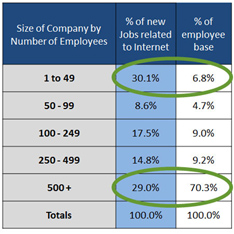 Our research also shows that small businesses create ten times (10x) more jobs related to the Internet as compared to large firms based on total employment. This is significant because if you’re looking to help create jobs in your region, it’s small businesses that are your biggest lever for local economic development.
Our research also shows that small businesses create ten times (10x) more jobs related to the Internet as compared to large firms based on total employment. This is significant because if you’re looking to help create jobs in your region, it’s small businesses that are your biggest lever for local economic development.
Also, given how much of new job creation is related to the Internet – broadband is becoming increasingly important for local economic development. Which means that without high quality, reliable and affordable bandwidth, it becomes increasingly challenging for firms of any size to stay competitive in an economy where more and more business activity and collaboration is online.
Joanna Taylor
In Europe there is a healthy competitive market for the telecommunication services, including broadband services, to end users. What is the basis for this competition? The fundamental attributes are explored briefly below. Could they be transferred to the western side of the Atlantic? There seems to be no reason why not!
 Economists and lawyers generally agree, to the extent that they agree upon anything, that healthy competition is a “good thing.” Competition drives down prices and encourages innovation while its opposite state, a monopoly creates an environment where innovation is limited and there is no market pressure driving down prices. In essence, an open, competitive market provides a higher degree of public good than a monopolistic, closed market focused on exploiting its market dominance to maintain high prices or restrict investment.
Economists and lawyers generally agree, to the extent that they agree upon anything, that healthy competition is a “good thing.” Competition drives down prices and encourages innovation while its opposite state, a monopoly creates an environment where innovation is limited and there is no market pressure driving down prices. In essence, an open, competitive market provides a higher degree of public good than a monopolistic, closed market focused on exploiting its market dominance to maintain high prices or restrict investment.
Economists and lawyers often refer to “natural monopolies,” as those that result from a set of circumstances where only one supplier is likely to enter the marketplace. It is argued that these conditions are present in the telecommunications access market. For example, when the final section of a wired (fixed line or last mile) service closest to a house or business premises is dedicated to the individual customer, and most customers only have the opportunity to purchase service from a select provider, there is very limited opportunity for a second provider to invest profitably in a duplicate access network. This is equally true in the broadband and mobile/wireless contexts and on both side of the Atlantic ocean.
Typically the incumbent, or first operator, will have created a largely universal copper network, and indeed has sometimes had an obligation to do so. In comparison, a new market entrant in its start-up phase would typically not be able to afford to re-create such a network in its entirety and will need the capability to link to the other network to provide the services they are marketing to potential customers. Typically, the service package includes the customer’s ability for their customer’s calls to connect with their competitor’s customers. However, if a new entrant’s network is unable to deliver calls made by its customers to people or organizations that procure services from another provider the new entrant will fail. In contrast, the profit maximising position for a monopoly network operator would be to refuse to deliver calls that originate from another network, or charge extortionate amounts to do so.
If market entry is to be encouraged, some form of regulation is required to force provider interconnection and control its prices.
In Europe, these twin concepts of the benefits of competition and the natural monopoly of the access market have long been recognized as appropriate solutions to sustainable competition and new market entry. Two recent public consultations on the regulatory regime have focussed on how to increase effective operation without any perceived need to discuss if the fundamentals require changing.
The European regulation that supports this service level competition is based on European competition law. The key difference is, however, that the regulation restricts behaviours in advance, ex-ante rather than ex-post, to prevent potential exploitation by operators of monopoly or quasi monopoly positions. As noted above, exploitative monopolistic behaviours may take the form of excessive pricing or market foreclosure, and the rules operate to counter both.
In brief, the system is as follows:
- The regulator has an obligation to review the telecommunication markets every few years and assess if any operator has significant market power (SMP), broadly equivalent to 40% market share, that would enable it to act anti-competitively,
- If an operator is found to have SMP, it can be required to offer wholesale services to other operators that enable them to compete on the retail market,
- These wholesale services should typically be offered on a non discriminatory basis to all other operators, and the retail arm of the operator with SMP should consume those same services when delivering services to its end customers, and
- The prices for the wholesale services should be cost orientated, and there should be sufficient margin between the wholesale and retail prices to cover the costs of retailing.
Over time the number of SMP markets has tended to fall, as competition has developed and entrants have built their own networks. A market entrant will initially invest in a core network, and as its customer base grows, it builds its network out towards the edge of the network, concentrating on the areas of highest customer density and value as this is where the opportunities are greatest . Former TV Cable operators may compete with the ex-incumbent in urban areas but SMP may remain with one, or both operators. The degree of competition in the access network remains limited outside city centres.
This European regulatory standards body is not without its critics, and its implementation, which varies somewhat country by country, could be improved but there is no doubt that the new regulatory standards have created an explosion of service level competition. Not only have consumers and businesses seen significant benefit, but also significant price reductions have been seen in the retail fixed and mobile markets.. Broadband services have got faster without price increases. In the European Union there are over 250 million internet users, with 95% of the population having fixed broadband access available to them, and virtually every European owns a mobile phone .
The regime has not restricted investment in infrastructure, as the roll out of fibre networks into high-density areas demonstrates. A proposal from Germany to exclude fibre networks from the rules was firmly rejected by the European Court of Justice in 2009.
The target for basic broadband for the 100% of the European Community by 2013 and 30mbits by 2020 is being made within this framework, and any development that uses pubic funds for network development is captured.
What would North America look like if this model were adopted? There is interconnection and the FCC requires some services to be offered on a wholesale level, but the whole process is shrouded in complexity. A general obligation for local access providers to provide wholesale services and to consume them themselves in a transparent and non-discriminatory manner might be just the catalyst the market needs!
How easy would a move to this model be? Well, that depends on the hearts and minds of those involved. The European model does not prevent operators being successful or prevent those who are inefficient from failing. The most successful are those that understand the logic of the competitive model and embrace it, whether as incumbent or entrant. Perhaps now is the time that this approach should be considered?
by John de Ridder
The popularity of Netflix illustrates how market and technology shifts are posing headaches for carriers. Canada has recently tried to address bandwidth pricing but expect more developments.
In 2007, Netflix started streaming its movie and television catalogue to subscribers in the USA and now has over 23 million customers in place. The same unlimited movie download offering was expanded to Canada in 2010 at a cost of $7.99 a month. By August 2011, the service had signed up 10% of Canada’s broadband households; where signing up the same percentage (albeit more homes) took six years in the United States.
The success of the Netflix offerings is starting to create headaches for carriers and ISPs as they do not get revenue contribution from over-the-top applications like Netflix and yet have to invest to carry the extra traffic. The headaches remain after the Canadian Radio-television and Telecommunications Commission’s (CRTC’s) recent decisions.
Bandwidth Headaches
Digitisation of broadband networks (both fixed and mobile) is causing tectonic shifts in business models. Traditionally, carriage and content went together: not any more. Entertainment was the ‘killer app’ that spurred the building of cable networks. The builders assumed they would be the providers of the content. But the impetus for delivering content over broadband is now coming from non-traditional sources that do not build the networks they rely on.
Not only have the builders of networks been deprived of the revenues that they expected out of video, but also have to augment their networks to keep-up with the growth in video traffic; for which they earn very little. Over half the current downstream traffic on fixed networks in North America is accounted for by real time entertainment.
“Intelligent broadband network solutions” provider Sandvine reports that Netflix accounted for 32.7 percent of all North American peak fixed access downstream content in the Fall of 2011. That puts Netflix way beyond the other three top Internet protocols or services by daily volume—approaching double HTTP (17.48 percent), almost three times YouTube (11.32), and nearly four times BitTorrent.
Some carriers’ knee-jerk reaction to the first manifestation of this kind of traffic was to block file-sharing networks like BitTorrent. This was discriminatory and not compatible with net neutrality.
The obvious neutral solution is to charge per GB irrespective of the content or its source. Volume based charging goes against the grain for those accustomed to unlimited downloads on broadband. And it is bad news for Netflix at about 2GB per hour (double with high definition) and average usage around 40GB per month. Twenty Organization for Economic Cooperation and Development (OECD) countries have no data caps at all among their broadband offers. But things are changing. Most Netflix customers are in the USA and in May 2011, AT&T slapped 150Gb and 250GB data caps on its DSL and U-Verse customers. This remedy has been over-turned in Canada.
Canada
In 2000 the CRTC permitted cable carriers to introduce usage caps and/or usage-based billing (UBB) charges for their wholesale services if UBB was also applied for their retail customers. Later, this option was extended to telephone companies offering broadband access.
On 25 January 2011 (Decision 2011-44), the Commission set the UBB rates at retail minus 15 percent. But the concession was not enough for many independent ISPs which together account for just 6 percent of the residential retail market. They hoped the CRTC would set a 50% discount. The January decision ignited consumer backlash and created a wave of public scorn that hit Ottawa ahead of the May federal election, quickly turning into a hot-button issue for a minority Conservative government and opposition parties alike. Also Netflix Inc. expressed serious concerns about its future in Canada – “[usage-based billing] is something we’re definitely worried about,” (Reed Hastings, chief executive of Netflix). On February 3, 2011, the federal Cabinet advised the CRTC that if it did not review the decision and come back with a new one, it would be reversed.
What does this mean going forward for bandwidth pricing?
The revised model that the CRTC finally produced on November 15, 2011 offers two options. First, for companies that proposed a usage-based model, their tariffs have to be based on the approved capacity model, effective February 1, 2012. For companies that proposed a flat rate model, their tariffs were approved effective immediately.
The capacity model requires ISPs to choose what bandwidth of pipe it wants in order to carry traffic between aggregation points (e.g. street cabinets) and the handover point. This is similar to the wholesale model proposed for the new broadband network in Australia. If ISPs do not order enough capacity, their traffic will become congested without affecting other ISPs.
This should appease Netflix and others but where is the incentive for ISPs to buy bigger pipes to accommodate traffic for which they get little or nothing? The bandwidth headache will remain until get to linear pricing on volumes. Data caps are just the first step towards that.
Sources:
CRTC Telecom Regulatory Policy CRTC 2011-703 [15 Nov 2011] http://www.crtc.gc.ca/eng/com100/2011/r111115.htm
Financial Post , 1 October 2011 http://www.nationalpost.com/news/Netflix+face+Canadian+regulations/5487301/story.html
Financial Post, 16 November 2011 http://www.financialpost.com/news/CRTC+ruling+hits+smaller+ISPs/5716827/story.html
OECD Communications Outlook, 2011
Sandvine, Global Internet Phenomena Report, Fall 2011 http://www.sandvine.com/news/global_broadband_trends.asp

Change is Hard… and So is Utilization
by Michael Curri & Doug Adams
In work across four American States, SNG research has found that not all e-solutions are created equally. Some are relatively easy to drive adoption and utilization… some are extremely different and require overcoming great challenges. When we plot out the utilization of various e-solutions versus SNG’s proprietary Digital Economy index (DEi) which measures the utilization of broadband as a platform for innovation, we see just how hard in what we’ve dubbed our “football chart” below. As a reminder, DEi scores range from 1 to 10 (10 being highest), with higher scores reflecting the greater the number, scope and sophistication of the Internet activities deployed in an organization.
As we discussed last month – businesses with a high DEi, meaning higher levels of adopting and using e-solutions, experience larger percentage increases of revenues (between 27 and 31%). Increasing Internet utilization dramatically increases corporate revenues and job creation.
So what does this have to do with the football chart? Let’s dig deeper and look at what separates the more successful organizations in utilizing broadband, creating efficiencies and growing revenues. It’s not the easy, “quick to adopt” solutions that include accessing government information online, sharing files, using collaborative tools, online research, and companies hosting their own website. These are all basic and even unsophisticated businesses are doing these.
But what separates the mediocre from the great… who is “winning” according to SNG’s research and the ‘football chart?’ The organizations that take on the difficult challenges, the more complicated e-solutions, are the businesses that are utilizing broadband to grow their business. These include:
- Teleworking – Using the Internet as your “virtual office,” enabling a geographically disparate workforce.
- Rich media – Creating multimedia content and interactive tools to market products/services and increase sales opportunities
- Social networking – Using today’s social network forums to promote business and collaborate with peer groups and colleagues
- eCommerce – Selling goods or services online – this can include driving leads toward payment and does not require online payment.
- Deliver services or content online – From customer service departments to digitized products.
Are you focusing on simply providing broadband and waiting for people to adopt… and ultimately utilize e-solutions (the tried and failed build it and they will come mentality) or are you driving utilization? Focus on driving sophisticated use of broadband and you’ll see your region’s economy reap the benefits. SNG has helped to look at where gaps are and prescribe next steps for economic development through broadband in communities and regions.
SNG Workshop in SC Helps to Drive Network Utilization
Earlier this month SNG’s Michael Curri and Derek Murphy travelled to South Carolina to assist in their broadband initiatives. Held by the Clemson Institute for Economic and Community Development and West Carolina Rural Telephone Cooperative (WCTel), the day long workshop gathered stakeholders interested in examining how broadband could help create a healthy and vibrant regional economy.
 Dave Herron, CEO of WCTel, explained that after completing a Fiber-to-the-Premise network throughout their rural service area, “we were faced with the challenge of trying to get our communities and economic development professionals to realize the value of the infrastructure they had available to them.”
Dave Herron, CEO of WCTel, explained that after completing a Fiber-to-the-Premise network throughout their rural service area, “we were faced with the challenge of trying to get our communities and economic development professionals to realize the value of the infrastructure they had available to them.”
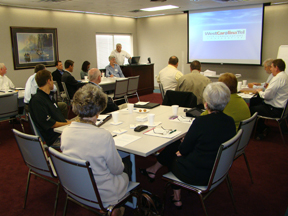 And that’s where SNG stepped in, along with Clemson University’s Institute of Economic and Community Development, to conduct a workshop for local economic development professionals, educational communities, Chambers of Commerce, State Dept. of Commerce, and several other community leaders. SNG’s expertise in maximizing the desirable outcomes enabled by investment in advanced broadband infrastructure were seen a key to demonstrate “what’s possible” with the WCTel network.
And that’s where SNG stepped in, along with Clemson University’s Institute of Economic and Community Development, to conduct a workshop for local economic development professionals, educational communities, Chambers of Commerce, State Dept. of Commerce, and several other community leaders. SNG’s expertise in maximizing the desirable outcomes enabled by investment in advanced broadband infrastructure were seen a key to demonstrate “what’s possible” with the WCTel network.
Explains Herron, “We needed to show local leaders how to utilize the network to promote economic and social development. We are committed to educating the community and are extremely hopeful that the leadership group formed will help in that effort, demonstrating to the communities how network utilization will to attract new industries, enhance existing businesses, and create jobs for our communities.”
Michael Curri explained how exciting it was to see a strong desire among the participants to work together – that day and in the future as they organized. “We helped create real momentum – it will be exciting to see the socio-economic benefits that will be realized thanks to the combination of the WCTel network and a mobilized leadership group.”
No Job doesn’t Mean No Earning Potential
- More from the SNG research front before we put a wrap on this month’s Bandwidth. It is encouraging to see 1 out of 4 of unemployed individuals using the Internet to start a home business. Another 25% are relying on the Internet for education and training to help them get their next job. Even the retired are using the Internet for both of these purposes.
Obviously, when considering how to cut back on personal expenses, the Internet bill should be taken off the table. Is it time that unemployment insurance include an Internet stipend? It’s worth considering given our findings.
n= 229 unemployed, 868 retired
by Michael Curri & Doug Adams
In work across four American States, SNG research has found that not all e-solutions are created equally. Some are relatively easy to drive adoption and utilization… some are extremely different and require overcoming great challenges. When we plot out the utilization of various e-solutions versus SNG’s proprietary Digital Economy index (DEi) which measures the utilization of broadband as a platform for innovation, we see just how hard in what we’ve dubbed our “football chart” below. As a reminder, DEi scores range from 1 to 10 (10 being highest), with higher scores reflecting the greater the number, scope and sophistication of the Internet activities deployed in an organization.
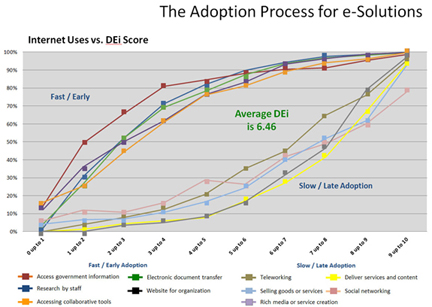
As we discussed last month – businesses with a high DEi, meaning higher levels of adopting and using e-solutions, experience larger percentage increases of revenues (between 27 and 31%). Increasing Internet utilization dramatically increases business revenues and job creation.
So what does this have to do with the football chart? Let’s dig deeper and look at what separates the more successful organizations in utilizing broadband, creating efficiencies and growing revenues. It’s not the easy, “quick to adopt” solutions that include accessing government information online, sharing files, using collaborative tools, online research, and companies hosting their own website. These are all basic and even unsophisticated businesses are doing these.
But what separates the mediocre from the great… who is “winning” according to SNG’s research and the ‘football chart?’ The organizations that take on the difficult challenges, the more complicated e-solutions, are the businesses that are utilizing broadband to grow their business. These include:
- Teleworking – Using the Internet as your “virtual office,” enabling a geographically disparate workforce.
- Rich media – Creating multimedia content and interactive tools to market products/services and increase sales opportunities
- Social networking – Using today’s social network forums to promote business and collaborate with peer groups and colleagues
- eCommerce – Selling goods or services online – this can include driving leads toward payment and does not require online payment.
- Deliver services or content online – From customer service departments to digitized products.
Are you focusing on simply providing broadband and waiting for people to adopt… and ultimately utilize e-solutions (the tried and failed build it and they will come mentality) or are you driving utilization? Focus on driving sophisticated use of broadband and you’ll see your region’s economy reap the benefits. SNG has helped to look at where gaps are and prescribe next steps for economic development through broadband in communities and regions.
Earlier this month SNG’s Michael Curri and Derek Murphy travelled to South Carolina to assist in their broadband initiatives. Held by the Clemson Institute for Economic and Community Development and West Carolina Rural Telephone Cooperative (WCTel), the day long workshop gathered stakeholders interested in examining how broadband could help create a healthy and vibrant regional economy.
 Dave Herron, CEO of WCTel, explained that after completing a Fiber-to-the-Premise network throughout their rural service area, “we were faced with the challenge of trying to get our communities and economic development professionals to realize the value of the infrastructure they had available to them.”
Dave Herron, CEO of WCTel, explained that after completing a Fiber-to-the-Premise network throughout their rural service area, “we were faced with the challenge of trying to get our communities and economic development professionals to realize the value of the infrastructure they had available to them.”
 And that’s where SNG stepped in, along with Clemson University’s Institute of Economic and Community Development, to conduct a workshop for local economic development professionals, educational communities, Chambers of Commerce, State Dept. of Commerce, and several other community leaders. SNG’s expertise in maximizing the desirable outcomes enabled by investment in advanced broadband infrastructure were seen a key to demonstrate “what’s possible” with the WCTel network.
And that’s where SNG stepped in, along with Clemson University’s Institute of Economic and Community Development, to conduct a workshop for local economic development professionals, educational communities, Chambers of Commerce, State Dept. of Commerce, and several other community leaders. SNG’s expertise in maximizing the desirable outcomes enabled by investment in advanced broadband infrastructure were seen a key to demonstrate “what’s possible” with the WCTel network.
Explains Herron, “We needed to show local leaders how to utilize the network to promote economic and social development. We are committed to educating the community and are extremely hopeful that the leadership group formed will help in that effort, demonstrating to the communities how network utilization will to attract new industries, enhance existing businesses, and create jobs for our communities.”
Michael Curri explained how exciting it was to see a strong desire among the participants to work together – that day and in the future as they organized. “We helped create real momentum – it will be exciting to see the socio-economic benefits that will be realized thanks to the combination of the WCTel network and a mobilized leadership group.”
More from the SNG research front before we put a wrap on this month’s Bandwidth. It is encouraging to see 1 out of 4 of unemployed individuals using the Internet to start a home business. Another 25% are relying on the Internet for education and training to help them get their next job. Even the retired are using the Internet for both of these purposes.
Obviously, when considering how to cut back on personal expenses, the Internet bill should be taken off the table. Is it time that unemployment insurance include an Internet stipend? It’s worth considering given our findings.
n= 229 unemployed, 868 retired

SNG Study Shows Broadband and e-Solutions Linked to Business Growth
by Michael Curri & Doug Adams
An SNG study of nearly 600 businesses in North Carolina has revealed a direct correlation between revenue growth and the adoption and use of e-solutions.
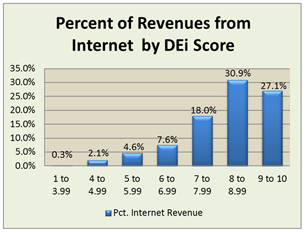 According to the research, higher levels of utilization generate higher revenues and greater benefits for businesses. The most significant impacts on a firm’s bottom line are more sophisticated e-solutions such as teleworking, selling goods or services online, etc. – which means that firms that are not ‘fully online’ are missing out on significant potential revenue. In some cases they could grow by up to 30%.
According to the research, higher levels of utilization generate higher revenues and greater benefits for businesses. The most significant impacts on a firm’s bottom line are more sophisticated e-solutions such as teleworking, selling goods or services online, etc. – which means that firms that are not ‘fully online’ are missing out on significant potential revenue. In some cases they could grow by up to 30%.
By measuring over 17 activities classified as “e-solutions,” or Internet enabled applications, SNG has developed a Digital Economy index (DEi) which measures the utilization of broadband as a platform for innovation. DEi scores range from 1 to 10 (10 being highest), with higher scores reflecting the greater the number, scope and sophistication of the Internet activities deployed in an organization.
The data indicate that businesses with a high DEi, meaning higher levels of adopting and using e-solutions, experience larger percentage increases of revenues (between 27 and 31%).
SNG’s research thus demonstrates that increasing Internet utilization dramatically increases corporate revenues and job creation.
The Impact of Broadband on Jobs
The North Carolina study reveals that the Internet contributes significantly to job growth, especially among organizations with less than 50 employees who represent over 94% of all firms and 44% of all employment.
The table below shows a complex dynamic where large numbers of jobs in over 1,000 organizations were created and lost over a 12 month period in 2009/2010. As in any economy where there is job creation and job loss, the most important challenge is to drive net positive job growth. North Carolina is seeing job loss (as shown in “% Net Jobs Created”). The key is how many sustainable, knowledge sector jobs they can create through innovation.
As the column “% Net Jobs Created thru Internet” indicates, small, nimble firms (less than 50 employees) are leveraging the Internet and e-solutions and creating new jobs at a rate of more than 8% of their existing base, which is a significant difference from the over 14% decline in job losses overall.
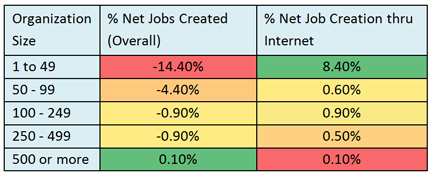 This picture of both job creation and loss is a more realistic insight into the process of economic change and development within North Carolina. One key finding from this table is that jobs associated with use of the Internet grew across all organizational sizes, even while major job losses were being experienced. This is particularly significant in organizations with 1 to 49 employees.
This picture of both job creation and loss is a more realistic insight into the process of economic change and development within North Carolina. One key finding from this table is that jobs associated with use of the Internet grew across all organizational sizes, even while major job losses were being experienced. This is particularly significant in organizations with 1 to 49 employees.
Broadband for Startups and Small Firms
Contributed by Roland J. Cole, Ph.D., J.D.
Residential broadband (distinguished from commercial broadband) is critical for bottom-up economic development. With this, there are a number of regions in the US (and in other countries) where big entities – private firms as well as government agencies, universities, and hospitals have access to broadband that is high speed and affordable, but the residences in that same community do not. In the US, while federal funds are being allocated to extend broadband to “community anchor institutions,” including hospitals, there is little or nothing being done to extend it to the residences around those institutions. I’ve seen one hospital program myself that refuses to share access with the offices of doctors that serve in the hospital, let alone the homes where they live. I’ve learned of a city that has, to great acclaim, extended its fiber to large firms, but feels that residences and small firms do not need anything better than the cable and telephone companies are currently providing.
As SNG has reported (most recently in the June Issue of Bandwidth that prompted me to write this piece), a lot of purely “economic” activity takes place in homes or in sites small enough that broadband network operators treat them as homes. In North Carolina, 1/3 of those with broadband already had a home-based business, and more than 1/10 were planning to start one within the year. These activities are in addition to employees of large firms that work from home. They are also above and beyond those using the Internet to seek employment opportunities, apply online, improve their skills, etc.
We’ve all heard stories of firms – countless numbers of them – that grew from basements, spare bedrooms, and garages. HP started in a garage; Dell started in a university dorm room. Some large firms that now include access to high-speed affordable broadband for their buildings as a top five or top ten item are now including access for their employees’ homes as a part of that item.
Residential broadband is important even for the firms that are out of the home, because small non-residential sites get offered the same bandwidth deals that homeowners get offered, albeit usually at twice or three times the price. The network providers (both public and private) do special deals for large end-users, but NOT for small ones.
Better bandwidth for these purposes is not just “speed” and price, because “speed” usually refers to download speed – largely a measure of consumption, not production. These individuals and small firms are producing, as well as consuming, and can use upload speed as well as download.
Video files are huge, CAD files are enormous, high-resolution photo files are large, database files have never been dainty… and you’re hard pressed to find organizations that do not include designers, marketers, architects, and engineers who need to transport these files. Of course you could deliver thumb drives with such files… but I also could send a letter as opposed to an email. I need to remain competitive, agile, and flexible to succeed in 2011. Lack of better broadband may not prevent home-based and small firm economic activity, but it sure discourages it. Better broadband provides the platform… the foundation to foster activities that grow businesses, and with them, our economies.
So for one measure of how “fertile” the ground is for bottom-up economic development activity in your community, track the price and upload speed offered to your residences. Do not be satisfied when your big companies and your “community anchor institutions” have reasonable broadband while residences do not. A big aid to the firms of the future, both large and small, is better residential bandwidth now.
Roland J. Cole is a lawyer and policy analyst (PhD/JD Harvard) who has been studying small business and economic development for over 30 years. His work has included three textbook chapters on the role of residential broadband and the development of a toolkit for community action in support of broadband improvement. He is currently a freelance policy analyst in Austin Texas, launching a new organization entitled Fertile Ground for Startups and Small Firms.
Learning about Learning Preferences
As a part of each SNG study, we take a close look not only at adoption rates and driving utilization – but also at preferred learning methods to bridge their skills gaps. It’s about individual users understanding which e-solutions will give them the biggest benefits and having the capacity to use those applications.
When individuals and households need to acquire knowledge, they turn to the resources they have at hand – and of course, the learning methods they prefer. It’s about moving businesses, organizations and households up the learning curve more effectively so that they realize the benefits from broadband and e-solutions as quickly and fully as possible.
Not surprisingly to our marketing department, among households “word of mouth” still scores high as a means for learning. But traditional methods are clearly taking a back seat to online learning – both informal (general surfing) and formal (webinars and online courses). Books, workshops, and classes all come after online methods (and word of mouth) as preferred learning methods. So it is clear that we have a bit of ‘chicken and the egg’ situation here as the question becomes – how does someone maximize their learning potential, without having online resources? The digital divide obviously goes hand-in-hand with a knowledge gap.
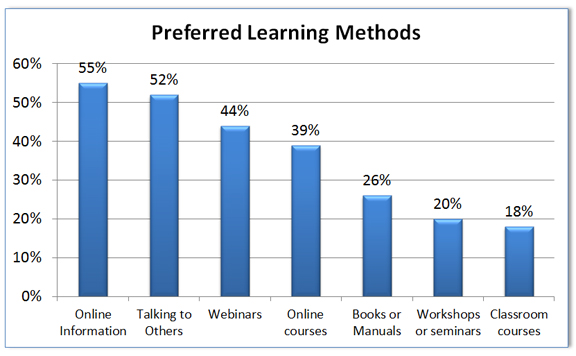
The same study revealed that 2 in 3 organizations plan to acquire at least two distinct skills sets over the next year – some through hiring, and some through training.
Here again we see a preference for online learning methods as self-directed methods of knowledge development, including online research and webinars, are the most likely to be used by the majority of organizations. In-person classroom training is the least likely method to be used.
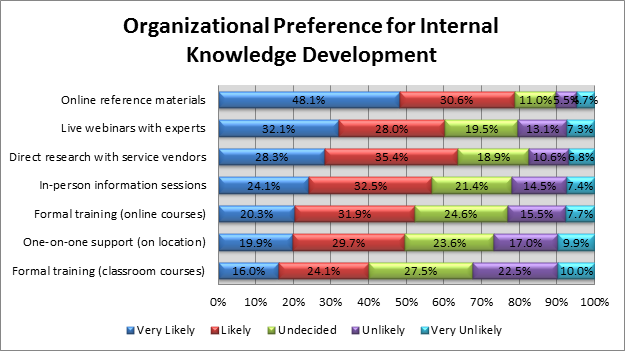
So, when planning for broadband, also plan for learning. Not only is it important to understand where the awareness and skills gaps are, but also understanding the preferred modes of learning. An effective strategy for economic development through broadband requires this.

